Marketing Strategies for Oral Hygiene Products
VerifiedAdded on 2020/05/11
|16
|5117
|77
AI Summary
This assignment delves into the realm of marketing strategies employed within the oral hygiene product category. It investigates the significance of brand positioning in driving profitability and analyzes typical consumer buying behaviors for these products. The impact of varying pricing preferences and brand selection on sales is also examined. Furthermore, the assignment explores strategic approaches organizations utilize to succeed in this competitive market, focusing on methods to enhance brand positioning within the toothpaste and oral hygiene product category.
Contribute Materials
Your contribution can guide someone’s learning journey. Share your
documents today.
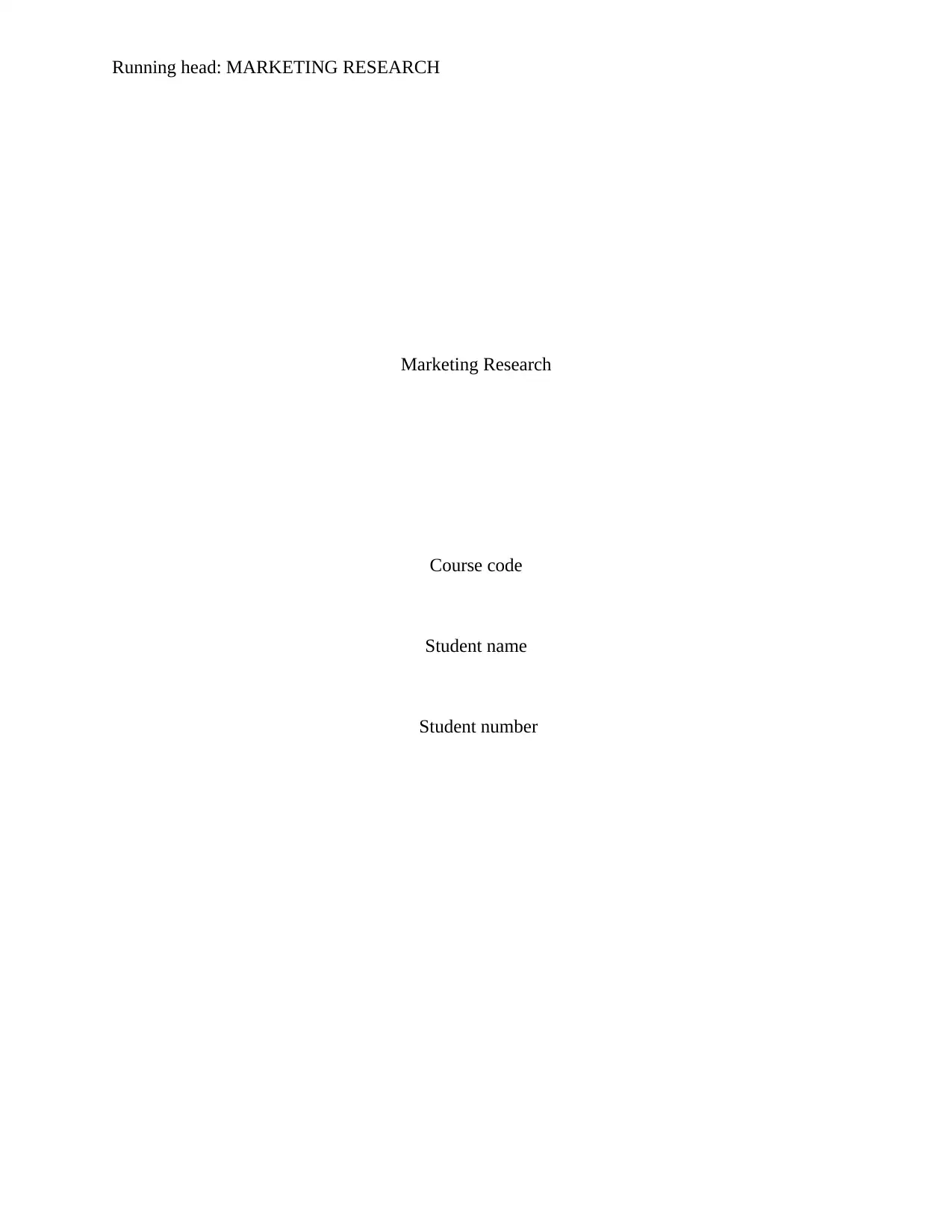
Running head: MARKETING RESEARCH
Marketing Research
Course code
Student name
Student number
Marketing Research
Course code
Student name
Student number
Secure Best Marks with AI Grader
Need help grading? Try our AI Grader for instant feedback on your assignments.
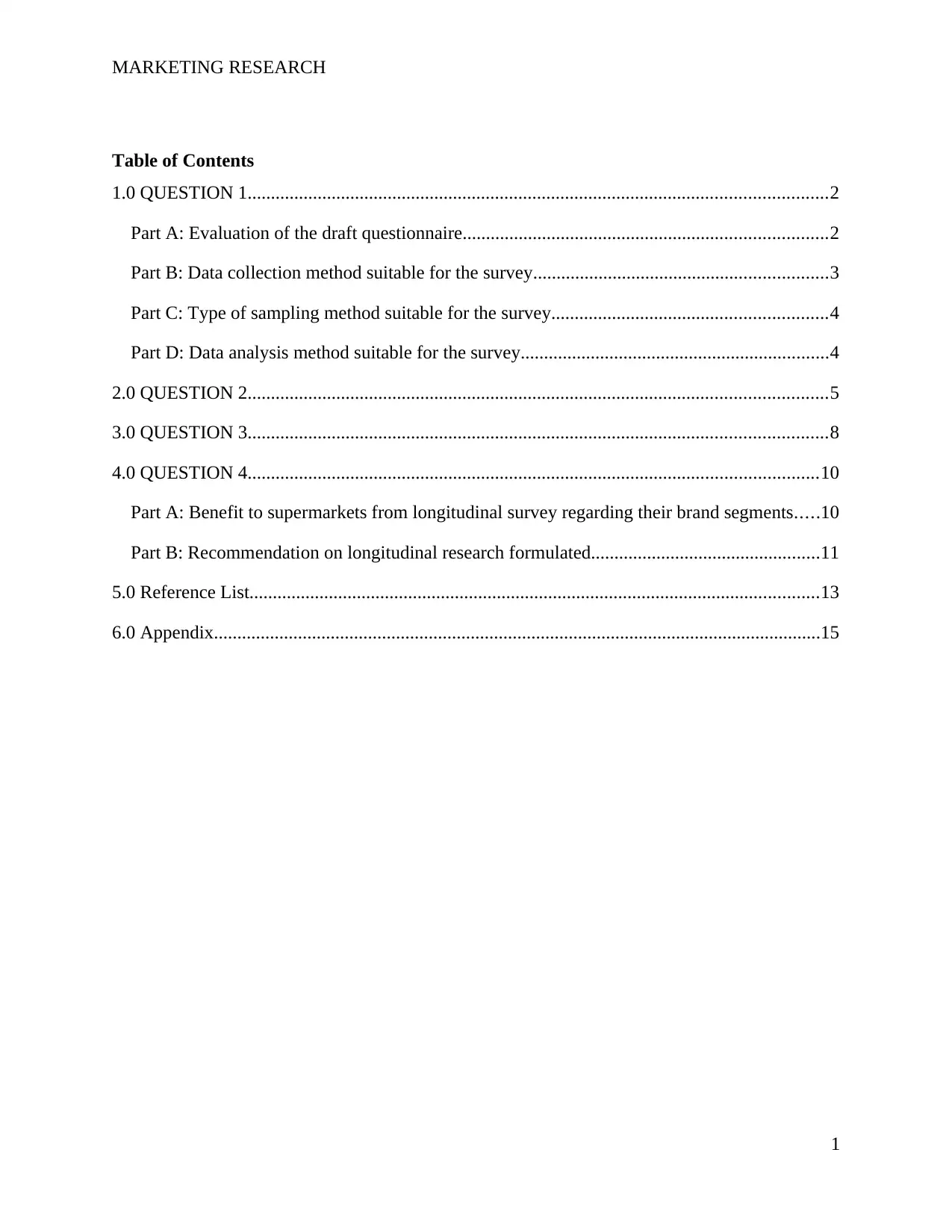
MARKETING RESEARCH
Table of Contents
1.0 QUESTION 1............................................................................................................................2
Part A: Evaluation of the draft questionnaire..............................................................................2
Part B: Data collection method suitable for the survey...............................................................3
Part C: Type of sampling method suitable for the survey...........................................................4
Part D: Data analysis method suitable for the survey..................................................................4
2.0 QUESTION 2............................................................................................................................5
3.0 QUESTION 3............................................................................................................................8
4.0 QUESTION 4..........................................................................................................................10
Part A: Benefit to supermarkets from longitudinal survey regarding their brand segments.....10
Part B: Recommendation on longitudinal research formulated.................................................11
5.0 Reference List..........................................................................................................................13
6.0 Appendix..................................................................................................................................15
1
Table of Contents
1.0 QUESTION 1............................................................................................................................2
Part A: Evaluation of the draft questionnaire..............................................................................2
Part B: Data collection method suitable for the survey...............................................................3
Part C: Type of sampling method suitable for the survey...........................................................4
Part D: Data analysis method suitable for the survey..................................................................4
2.0 QUESTION 2............................................................................................................................5
3.0 QUESTION 3............................................................................................................................8
4.0 QUESTION 4..........................................................................................................................10
Part A: Benefit to supermarkets from longitudinal survey regarding their brand segments.....10
Part B: Recommendation on longitudinal research formulated.................................................11
5.0 Reference List..........................................................................................................................13
6.0 Appendix..................................................................................................................................15
1
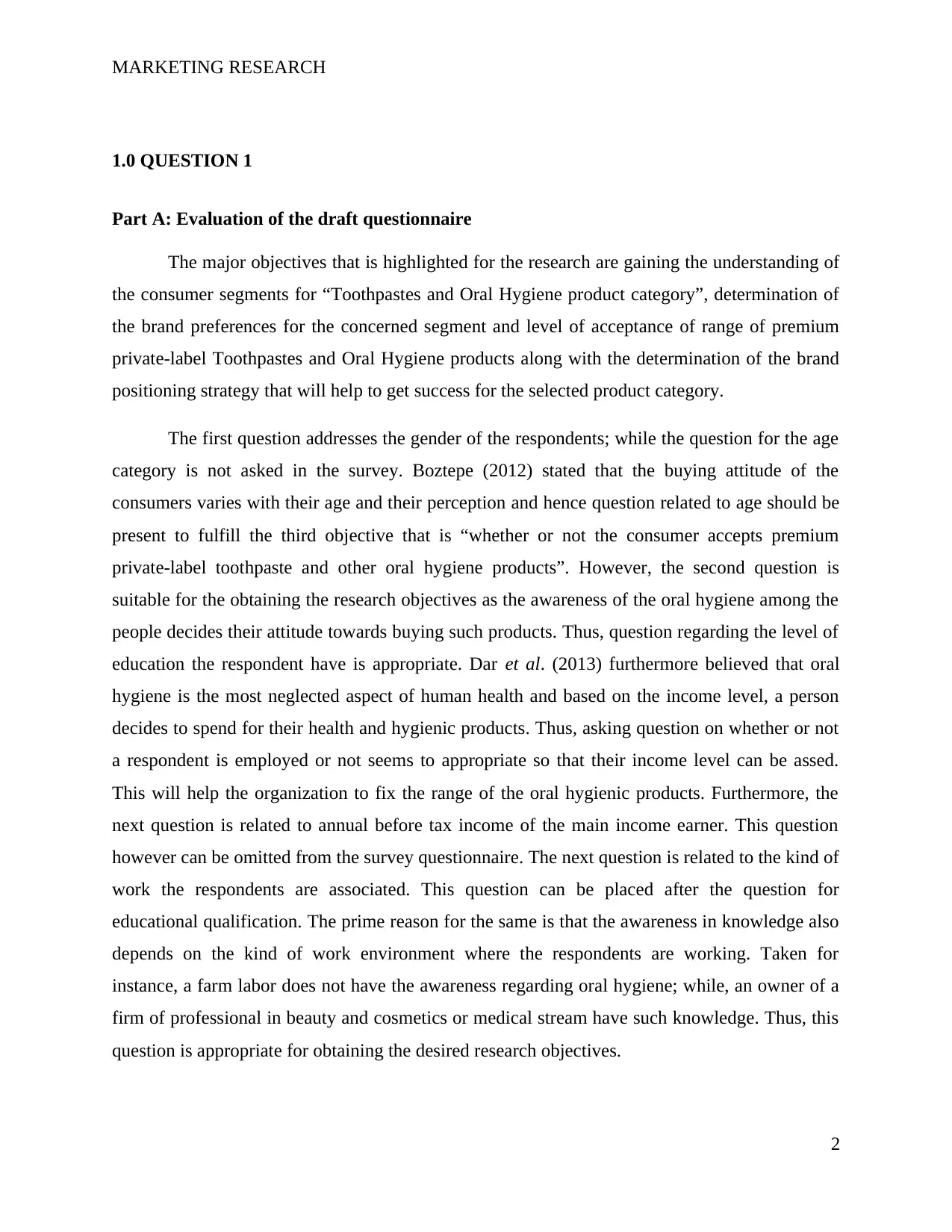
MARKETING RESEARCH
1.0 QUESTION 1
Part A: Evaluation of the draft questionnaire
The major objectives that is highlighted for the research are gaining the understanding of
the consumer segments for “Toothpastes and Oral Hygiene product category”, determination of
the brand preferences for the concerned segment and level of acceptance of range of premium
private-label Toothpastes and Oral Hygiene products along with the determination of the brand
positioning strategy that will help to get success for the selected product category.
The first question addresses the gender of the respondents; while the question for the age
category is not asked in the survey. Boztepe (2012) stated that the buying attitude of the
consumers varies with their age and their perception and hence question related to age should be
present to fulfill the third objective that is “whether or not the consumer accepts premium
private-label toothpaste and other oral hygiene products”. However, the second question is
suitable for the obtaining the research objectives as the awareness of the oral hygiene among the
people decides their attitude towards buying such products. Thus, question regarding the level of
education the respondent have is appropriate. Dar et al. (2013) furthermore believed that oral
hygiene is the most neglected aspect of human health and based on the income level, a person
decides to spend for their health and hygienic products. Thus, asking question on whether or not
a respondent is employed or not seems to appropriate so that their income level can be assed.
This will help the organization to fix the range of the oral hygienic products. Furthermore, the
next question is related to annual before tax income of the main income earner. This question
however can be omitted from the survey questionnaire. The next question is related to the kind of
work the respondents are associated. This question can be placed after the question for
educational qualification. The prime reason for the same is that the awareness in knowledge also
depends on the kind of work environment where the respondents are working. Taken for
instance, a farm labor does not have the awareness regarding oral hygiene; while, an owner of a
firm of professional in beauty and cosmetics or medical stream have such knowledge. Thus, this
question is appropriate for obtaining the desired research objectives.
2
1.0 QUESTION 1
Part A: Evaluation of the draft questionnaire
The major objectives that is highlighted for the research are gaining the understanding of
the consumer segments for “Toothpastes and Oral Hygiene product category”, determination of
the brand preferences for the concerned segment and level of acceptance of range of premium
private-label Toothpastes and Oral Hygiene products along with the determination of the brand
positioning strategy that will help to get success for the selected product category.
The first question addresses the gender of the respondents; while the question for the age
category is not asked in the survey. Boztepe (2012) stated that the buying attitude of the
consumers varies with their age and their perception and hence question related to age should be
present to fulfill the third objective that is “whether or not the consumer accepts premium
private-label toothpaste and other oral hygiene products”. However, the second question is
suitable for the obtaining the research objectives as the awareness of the oral hygiene among the
people decides their attitude towards buying such products. Thus, question regarding the level of
education the respondent have is appropriate. Dar et al. (2013) furthermore believed that oral
hygiene is the most neglected aspect of human health and based on the income level, a person
decides to spend for their health and hygienic products. Thus, asking question on whether or not
a respondent is employed or not seems to appropriate so that their income level can be assed.
This will help the organization to fix the range of the oral hygienic products. Furthermore, the
next question is related to annual before tax income of the main income earner. This question
however can be omitted from the survey questionnaire. The next question is related to the kind of
work the respondents are associated. This question can be placed after the question for
educational qualification. The prime reason for the same is that the awareness in knowledge also
depends on the kind of work environment where the respondents are working. Taken for
instance, a farm labor does not have the awareness regarding oral hygiene; while, an owner of a
firm of professional in beauty and cosmetics or medical stream have such knowledge. Thus, this
question is appropriate for obtaining the desired research objectives.
2
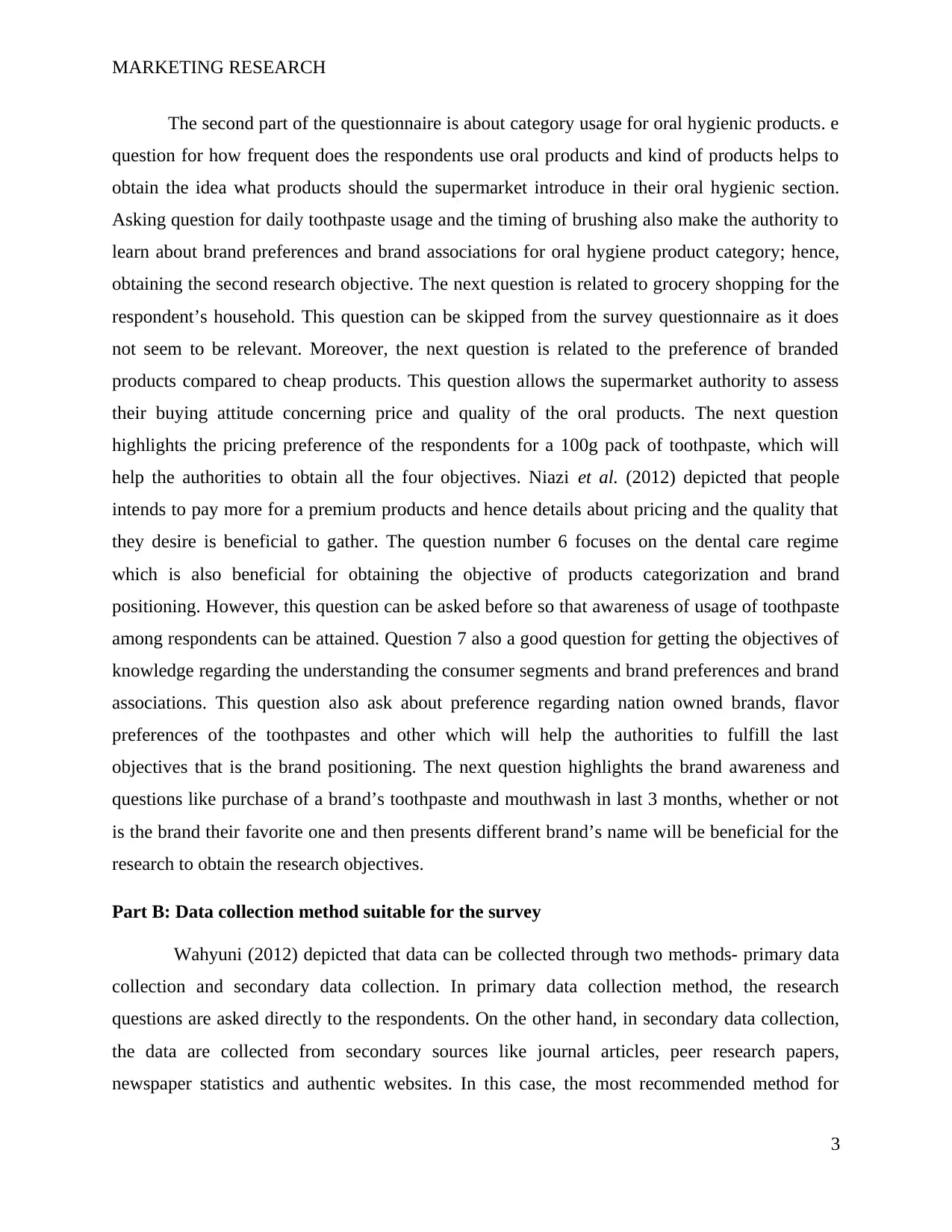
MARKETING RESEARCH
The second part of the questionnaire is about category usage for oral hygienic products. e
question for how frequent does the respondents use oral products and kind of products helps to
obtain the idea what products should the supermarket introduce in their oral hygienic section.
Asking question for daily toothpaste usage and the timing of brushing also make the authority to
learn about brand preferences and brand associations for oral hygiene product category; hence,
obtaining the second research objective. The next question is related to grocery shopping for the
respondent’s household. This question can be skipped from the survey questionnaire as it does
not seem to be relevant. Moreover, the next question is related to the preference of branded
products compared to cheap products. This question allows the supermarket authority to assess
their buying attitude concerning price and quality of the oral products. The next question
highlights the pricing preference of the respondents for a 100g pack of toothpaste, which will
help the authorities to obtain all the four objectives. Niazi et al. (2012) depicted that people
intends to pay more for a premium products and hence details about pricing and the quality that
they desire is beneficial to gather. The question number 6 focuses on the dental care regime
which is also beneficial for obtaining the objective of products categorization and brand
positioning. However, this question can be asked before so that awareness of usage of toothpaste
among respondents can be attained. Question 7 also a good question for getting the objectives of
knowledge regarding the understanding the consumer segments and brand preferences and brand
associations. This question also ask about preference regarding nation owned brands, flavor
preferences of the toothpastes and other which will help the authorities to fulfill the last
objectives that is the brand positioning. The next question highlights the brand awareness and
questions like purchase of a brand’s toothpaste and mouthwash in last 3 months, whether or not
is the brand their favorite one and then presents different brand’s name will be beneficial for the
research to obtain the research objectives.
Part B: Data collection method suitable for the survey
Wahyuni (2012) depicted that data can be collected through two methods- primary data
collection and secondary data collection. In primary data collection method, the research
questions are asked directly to the respondents. On the other hand, in secondary data collection,
the data are collected from secondary sources like journal articles, peer research papers,
newspaper statistics and authentic websites. In this case, the most recommended method for
3
The second part of the questionnaire is about category usage for oral hygienic products. e
question for how frequent does the respondents use oral products and kind of products helps to
obtain the idea what products should the supermarket introduce in their oral hygienic section.
Asking question for daily toothpaste usage and the timing of brushing also make the authority to
learn about brand preferences and brand associations for oral hygiene product category; hence,
obtaining the second research objective. The next question is related to grocery shopping for the
respondent’s household. This question can be skipped from the survey questionnaire as it does
not seem to be relevant. Moreover, the next question is related to the preference of branded
products compared to cheap products. This question allows the supermarket authority to assess
their buying attitude concerning price and quality of the oral products. The next question
highlights the pricing preference of the respondents for a 100g pack of toothpaste, which will
help the authorities to obtain all the four objectives. Niazi et al. (2012) depicted that people
intends to pay more for a premium products and hence details about pricing and the quality that
they desire is beneficial to gather. The question number 6 focuses on the dental care regime
which is also beneficial for obtaining the objective of products categorization and brand
positioning. However, this question can be asked before so that awareness of usage of toothpaste
among respondents can be attained. Question 7 also a good question for getting the objectives of
knowledge regarding the understanding the consumer segments and brand preferences and brand
associations. This question also ask about preference regarding nation owned brands, flavor
preferences of the toothpastes and other which will help the authorities to fulfill the last
objectives that is the brand positioning. The next question highlights the brand awareness and
questions like purchase of a brand’s toothpaste and mouthwash in last 3 months, whether or not
is the brand their favorite one and then presents different brand’s name will be beneficial for the
research to obtain the research objectives.
Part B: Data collection method suitable for the survey
Wahyuni (2012) depicted that data can be collected through two methods- primary data
collection and secondary data collection. In primary data collection method, the research
questions are asked directly to the respondents. On the other hand, in secondary data collection,
the data are collected from secondary sources like journal articles, peer research papers,
newspaper statistics and authentic websites. In this case, the most recommended method for
3
Secure Best Marks with AI Grader
Need help grading? Try our AI Grader for instant feedback on your assignments.
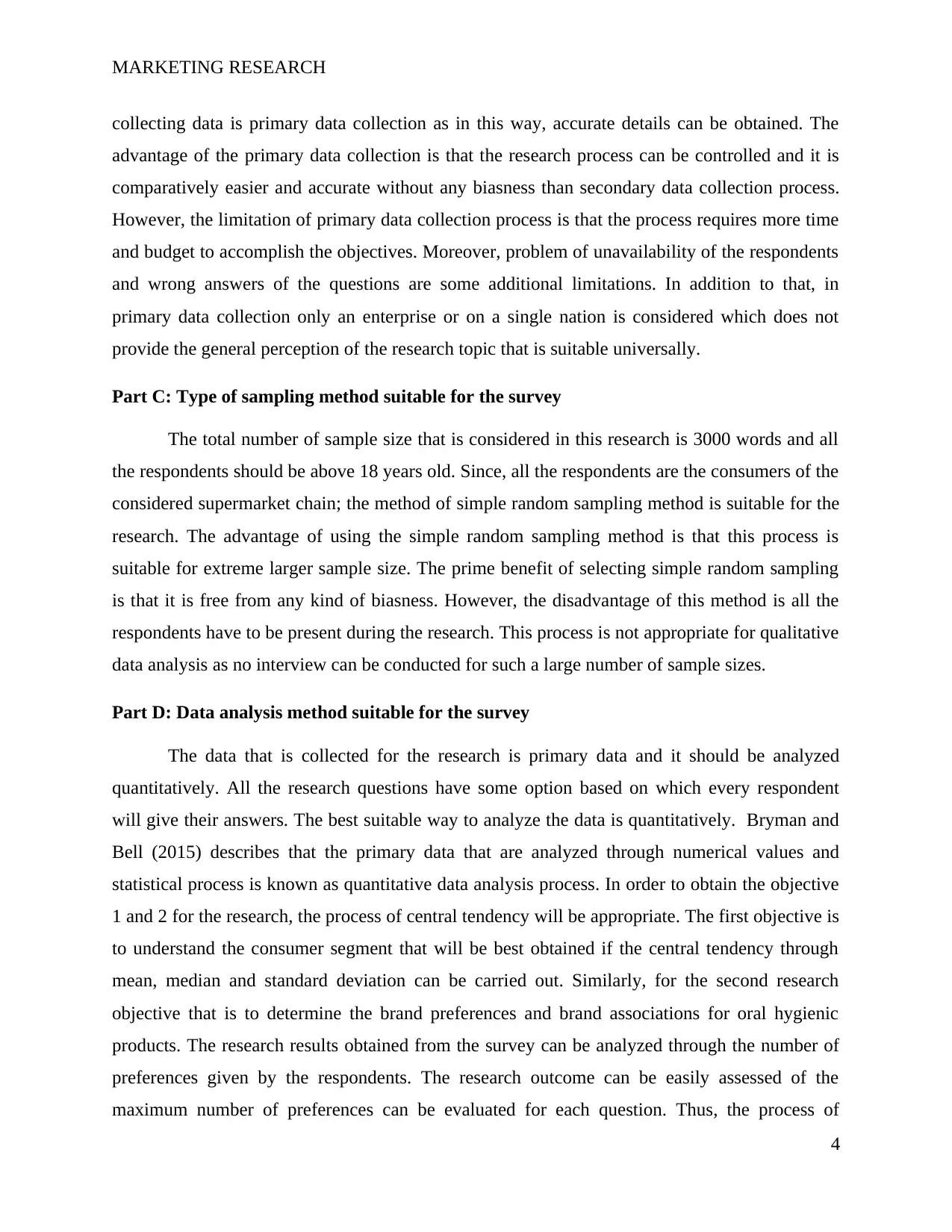
MARKETING RESEARCH
collecting data is primary data collection as in this way, accurate details can be obtained. The
advantage of the primary data collection is that the research process can be controlled and it is
comparatively easier and accurate without any biasness than secondary data collection process.
However, the limitation of primary data collection process is that the process requires more time
and budget to accomplish the objectives. Moreover, problem of unavailability of the respondents
and wrong answers of the questions are some additional limitations. In addition to that, in
primary data collection only an enterprise or on a single nation is considered which does not
provide the general perception of the research topic that is suitable universally.
Part C: Type of sampling method suitable for the survey
The total number of sample size that is considered in this research is 3000 words and all
the respondents should be above 18 years old. Since, all the respondents are the consumers of the
considered supermarket chain; the method of simple random sampling method is suitable for the
research. The advantage of using the simple random sampling method is that this process is
suitable for extreme larger sample size. The prime benefit of selecting simple random sampling
is that it is free from any kind of biasness. However, the disadvantage of this method is all the
respondents have to be present during the research. This process is not appropriate for qualitative
data analysis as no interview can be conducted for such a large number of sample sizes.
Part D: Data analysis method suitable for the survey
The data that is collected for the research is primary data and it should be analyzed
quantitatively. All the research questions have some option based on which every respondent
will give their answers. The best suitable way to analyze the data is quantitatively. Bryman and
Bell (2015) describes that the primary data that are analyzed through numerical values and
statistical process is known as quantitative data analysis process. In order to obtain the objective
1 and 2 for the research, the process of central tendency will be appropriate. The first objective is
to understand the consumer segment that will be best obtained if the central tendency through
mean, median and standard deviation can be carried out. Similarly, for the second research
objective that is to determine the brand preferences and brand associations for oral hygienic
products. The research results obtained from the survey can be analyzed through the number of
preferences given by the respondents. The research outcome can be easily assessed of the
maximum number of preferences can be evaluated for each question. Thus, the process of
4
collecting data is primary data collection as in this way, accurate details can be obtained. The
advantage of the primary data collection is that the research process can be controlled and it is
comparatively easier and accurate without any biasness than secondary data collection process.
However, the limitation of primary data collection process is that the process requires more time
and budget to accomplish the objectives. Moreover, problem of unavailability of the respondents
and wrong answers of the questions are some additional limitations. In addition to that, in
primary data collection only an enterprise or on a single nation is considered which does not
provide the general perception of the research topic that is suitable universally.
Part C: Type of sampling method suitable for the survey
The total number of sample size that is considered in this research is 3000 words and all
the respondents should be above 18 years old. Since, all the respondents are the consumers of the
considered supermarket chain; the method of simple random sampling method is suitable for the
research. The advantage of using the simple random sampling method is that this process is
suitable for extreme larger sample size. The prime benefit of selecting simple random sampling
is that it is free from any kind of biasness. However, the disadvantage of this method is all the
respondents have to be present during the research. This process is not appropriate for qualitative
data analysis as no interview can be conducted for such a large number of sample sizes.
Part D: Data analysis method suitable for the survey
The data that is collected for the research is primary data and it should be analyzed
quantitatively. All the research questions have some option based on which every respondent
will give their answers. The best suitable way to analyze the data is quantitatively. Bryman and
Bell (2015) describes that the primary data that are analyzed through numerical values and
statistical process is known as quantitative data analysis process. In order to obtain the objective
1 and 2 for the research, the process of central tendency will be appropriate. The first objective is
to understand the consumer segment that will be best obtained if the central tendency through
mean, median and standard deviation can be carried out. Similarly, for the second research
objective that is to determine the brand preferences and brand associations for oral hygienic
products. The research results obtained from the survey can be analyzed through the number of
preferences given by the respondents. The research outcome can be easily assessed of the
maximum number of preferences can be evaluated for each question. Thus, the process of
4
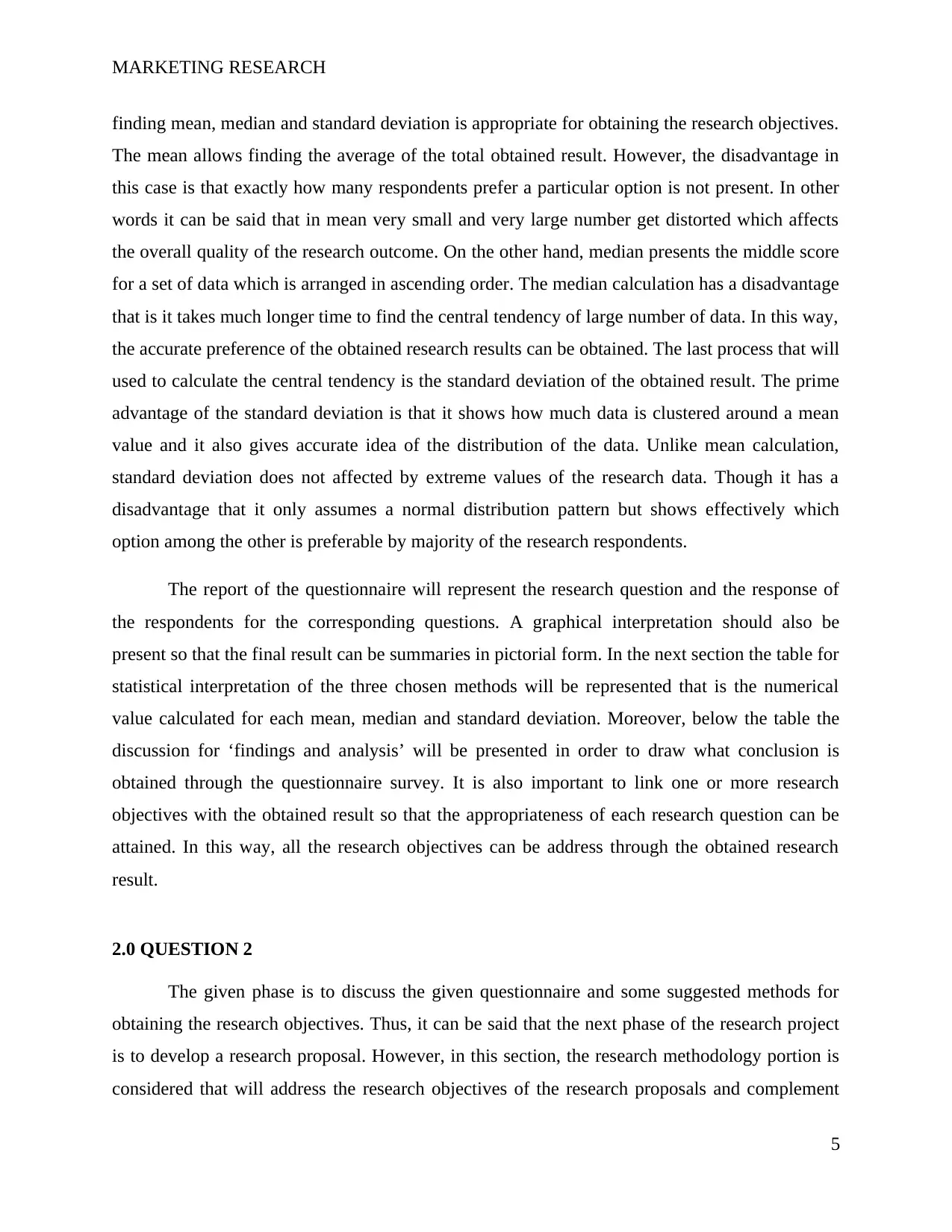
MARKETING RESEARCH
finding mean, median and standard deviation is appropriate for obtaining the research objectives.
The mean allows finding the average of the total obtained result. However, the disadvantage in
this case is that exactly how many respondents prefer a particular option is not present. In other
words it can be said that in mean very small and very large number get distorted which affects
the overall quality of the research outcome. On the other hand, median presents the middle score
for a set of data which is arranged in ascending order. The median calculation has a disadvantage
that is it takes much longer time to find the central tendency of large number of data. In this way,
the accurate preference of the obtained research results can be obtained. The last process that will
used to calculate the central tendency is the standard deviation of the obtained result. The prime
advantage of the standard deviation is that it shows how much data is clustered around a mean
value and it also gives accurate idea of the distribution of the data. Unlike mean calculation,
standard deviation does not affected by extreme values of the research data. Though it has a
disadvantage that it only assumes a normal distribution pattern but shows effectively which
option among the other is preferable by majority of the research respondents.
The report of the questionnaire will represent the research question and the response of
the respondents for the corresponding questions. A graphical interpretation should also be
present so that the final result can be summaries in pictorial form. In the next section the table for
statistical interpretation of the three chosen methods will be represented that is the numerical
value calculated for each mean, median and standard deviation. Moreover, below the table the
discussion for ‘findings and analysis’ will be presented in order to draw what conclusion is
obtained through the questionnaire survey. It is also important to link one or more research
objectives with the obtained result so that the appropriateness of each research question can be
attained. In this way, all the research objectives can be address through the obtained research
result.
2.0 QUESTION 2
The given phase is to discuss the given questionnaire and some suggested methods for
obtaining the research objectives. Thus, it can be said that the next phase of the research project
is to develop a research proposal. However, in this section, the research methodology portion is
considered that will address the research objectives of the research proposals and complement
5
finding mean, median and standard deviation is appropriate for obtaining the research objectives.
The mean allows finding the average of the total obtained result. However, the disadvantage in
this case is that exactly how many respondents prefer a particular option is not present. In other
words it can be said that in mean very small and very large number get distorted which affects
the overall quality of the research outcome. On the other hand, median presents the middle score
for a set of data which is arranged in ascending order. The median calculation has a disadvantage
that is it takes much longer time to find the central tendency of large number of data. In this way,
the accurate preference of the obtained research results can be obtained. The last process that will
used to calculate the central tendency is the standard deviation of the obtained result. The prime
advantage of the standard deviation is that it shows how much data is clustered around a mean
value and it also gives accurate idea of the distribution of the data. Unlike mean calculation,
standard deviation does not affected by extreme values of the research data. Though it has a
disadvantage that it only assumes a normal distribution pattern but shows effectively which
option among the other is preferable by majority of the research respondents.
The report of the questionnaire will represent the research question and the response of
the respondents for the corresponding questions. A graphical interpretation should also be
present so that the final result can be summaries in pictorial form. In the next section the table for
statistical interpretation of the three chosen methods will be represented that is the numerical
value calculated for each mean, median and standard deviation. Moreover, below the table the
discussion for ‘findings and analysis’ will be presented in order to draw what conclusion is
obtained through the questionnaire survey. It is also important to link one or more research
objectives with the obtained result so that the appropriateness of each research question can be
attained. In this way, all the research objectives can be address through the obtained research
result.
2.0 QUESTION 2
The given phase is to discuss the given questionnaire and some suggested methods for
obtaining the research objectives. Thus, it can be said that the next phase of the research project
is to develop a research proposal. However, in this section, the research methodology portion is
considered that will address the research objectives of the research proposals and complement
5
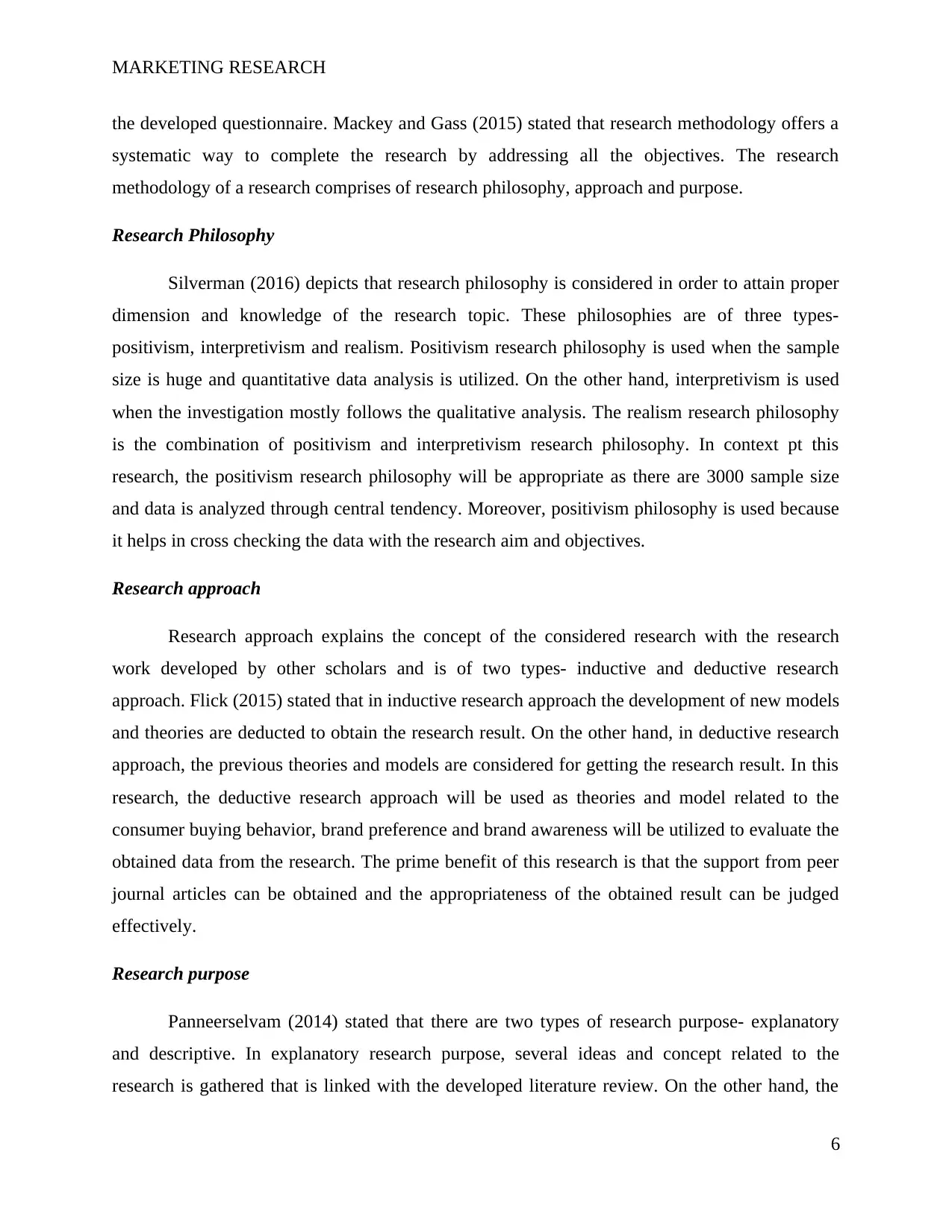
MARKETING RESEARCH
the developed questionnaire. Mackey and Gass (2015) stated that research methodology offers a
systematic way to complete the research by addressing all the objectives. The research
methodology of a research comprises of research philosophy, approach and purpose.
Research Philosophy
Silverman (2016) depicts that research philosophy is considered in order to attain proper
dimension and knowledge of the research topic. These philosophies are of three types-
positivism, interpretivism and realism. Positivism research philosophy is used when the sample
size is huge and quantitative data analysis is utilized. On the other hand, interpretivism is used
when the investigation mostly follows the qualitative analysis. The realism research philosophy
is the combination of positivism and interpretivism research philosophy. In context pt this
research, the positivism research philosophy will be appropriate as there are 3000 sample size
and data is analyzed through central tendency. Moreover, positivism philosophy is used because
it helps in cross checking the data with the research aim and objectives.
Research approach
Research approach explains the concept of the considered research with the research
work developed by other scholars and is of two types- inductive and deductive research
approach. Flick (2015) stated that in inductive research approach the development of new models
and theories are deducted to obtain the research result. On the other hand, in deductive research
approach, the previous theories and models are considered for getting the research result. In this
research, the deductive research approach will be used as theories and model related to the
consumer buying behavior, brand preference and brand awareness will be utilized to evaluate the
obtained data from the research. The prime benefit of this research is that the support from peer
journal articles can be obtained and the appropriateness of the obtained result can be judged
effectively.
Research purpose
Panneerselvam (2014) stated that there are two types of research purpose- explanatory
and descriptive. In explanatory research purpose, several ideas and concept related to the
research is gathered that is linked with the developed literature review. On the other hand, the
6
the developed questionnaire. Mackey and Gass (2015) stated that research methodology offers a
systematic way to complete the research by addressing all the objectives. The research
methodology of a research comprises of research philosophy, approach and purpose.
Research Philosophy
Silverman (2016) depicts that research philosophy is considered in order to attain proper
dimension and knowledge of the research topic. These philosophies are of three types-
positivism, interpretivism and realism. Positivism research philosophy is used when the sample
size is huge and quantitative data analysis is utilized. On the other hand, interpretivism is used
when the investigation mostly follows the qualitative analysis. The realism research philosophy
is the combination of positivism and interpretivism research philosophy. In context pt this
research, the positivism research philosophy will be appropriate as there are 3000 sample size
and data is analyzed through central tendency. Moreover, positivism philosophy is used because
it helps in cross checking the data with the research aim and objectives.
Research approach
Research approach explains the concept of the considered research with the research
work developed by other scholars and is of two types- inductive and deductive research
approach. Flick (2015) stated that in inductive research approach the development of new models
and theories are deducted to obtain the research result. On the other hand, in deductive research
approach, the previous theories and models are considered for getting the research result. In this
research, the deductive research approach will be used as theories and model related to the
consumer buying behavior, brand preference and brand awareness will be utilized to evaluate the
obtained data from the research. The prime benefit of this research is that the support from peer
journal articles can be obtained and the appropriateness of the obtained result can be judged
effectively.
Research purpose
Panneerselvam (2014) stated that there are two types of research purpose- explanatory
and descriptive. In explanatory research purpose, several ideas and concept related to the
research is gathered that is linked with the developed literature review. On the other hand, the
6
Paraphrase This Document
Need a fresh take? Get an instant paraphrase of this document with our AI Paraphraser
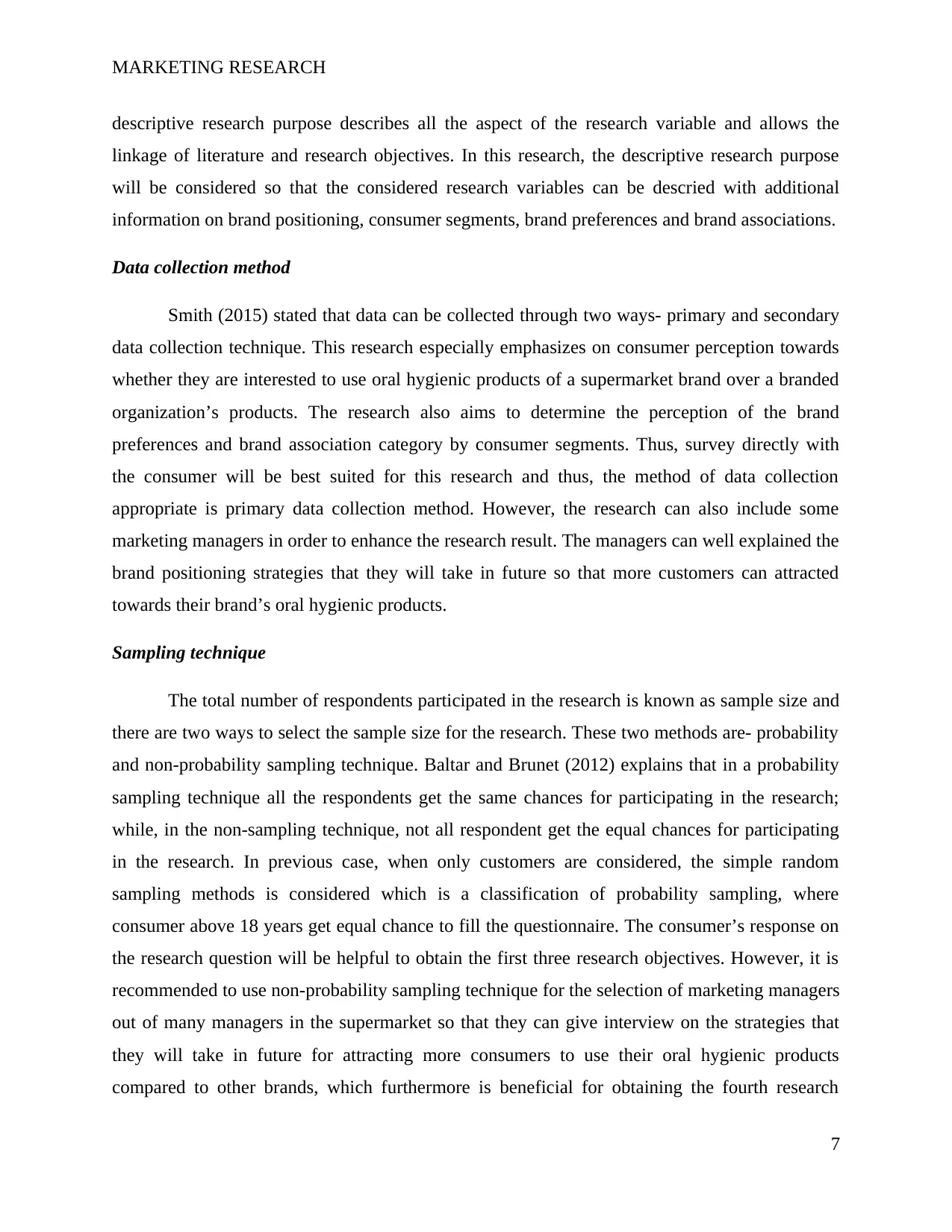
MARKETING RESEARCH
descriptive research purpose describes all the aspect of the research variable and allows the
linkage of literature and research objectives. In this research, the descriptive research purpose
will be considered so that the considered research variables can be descried with additional
information on brand positioning, consumer segments, brand preferences and brand associations.
Data collection method
Smith (2015) stated that data can be collected through two ways- primary and secondary
data collection technique. This research especially emphasizes on consumer perception towards
whether they are interested to use oral hygienic products of a supermarket brand over a branded
organization’s products. The research also aims to determine the perception of the brand
preferences and brand association category by consumer segments. Thus, survey directly with
the consumer will be best suited for this research and thus, the method of data collection
appropriate is primary data collection method. However, the research can also include some
marketing managers in order to enhance the research result. The managers can well explained the
brand positioning strategies that they will take in future so that more customers can attracted
towards their brand’s oral hygienic products.
Sampling technique
The total number of respondents participated in the research is known as sample size and
there are two ways to select the sample size for the research. These two methods are- probability
and non-probability sampling technique. Baltar and Brunet (2012) explains that in a probability
sampling technique all the respondents get the same chances for participating in the research;
while, in the non-sampling technique, not all respondent get the equal chances for participating
in the research. In previous case, when only customers are considered, the simple random
sampling methods is considered which is a classification of probability sampling, where
consumer above 18 years get equal chance to fill the questionnaire. The consumer’s response on
the research question will be helpful to obtain the first three research objectives. However, it is
recommended to use non-probability sampling technique for the selection of marketing managers
out of many managers in the supermarket so that they can give interview on the strategies that
they will take in future for attracting more consumers to use their oral hygienic products
compared to other brands, which furthermore is beneficial for obtaining the fourth research
7
descriptive research purpose describes all the aspect of the research variable and allows the
linkage of literature and research objectives. In this research, the descriptive research purpose
will be considered so that the considered research variables can be descried with additional
information on brand positioning, consumer segments, brand preferences and brand associations.
Data collection method
Smith (2015) stated that data can be collected through two ways- primary and secondary
data collection technique. This research especially emphasizes on consumer perception towards
whether they are interested to use oral hygienic products of a supermarket brand over a branded
organization’s products. The research also aims to determine the perception of the brand
preferences and brand association category by consumer segments. Thus, survey directly with
the consumer will be best suited for this research and thus, the method of data collection
appropriate is primary data collection method. However, the research can also include some
marketing managers in order to enhance the research result. The managers can well explained the
brand positioning strategies that they will take in future so that more customers can attracted
towards their brand’s oral hygienic products.
Sampling technique
The total number of respondents participated in the research is known as sample size and
there are two ways to select the sample size for the research. These two methods are- probability
and non-probability sampling technique. Baltar and Brunet (2012) explains that in a probability
sampling technique all the respondents get the same chances for participating in the research;
while, in the non-sampling technique, not all respondent get the equal chances for participating
in the research. In previous case, when only customers are considered, the simple random
sampling methods is considered which is a classification of probability sampling, where
consumer above 18 years get equal chance to fill the questionnaire. The consumer’s response on
the research question will be helpful to obtain the first three research objectives. However, it is
recommended to use non-probability sampling technique for the selection of marketing managers
out of many managers in the supermarket so that they can give interview on the strategies that
they will take in future for attracting more consumers to use their oral hygienic products
compared to other brands, which furthermore is beneficial for obtaining the fourth research
7
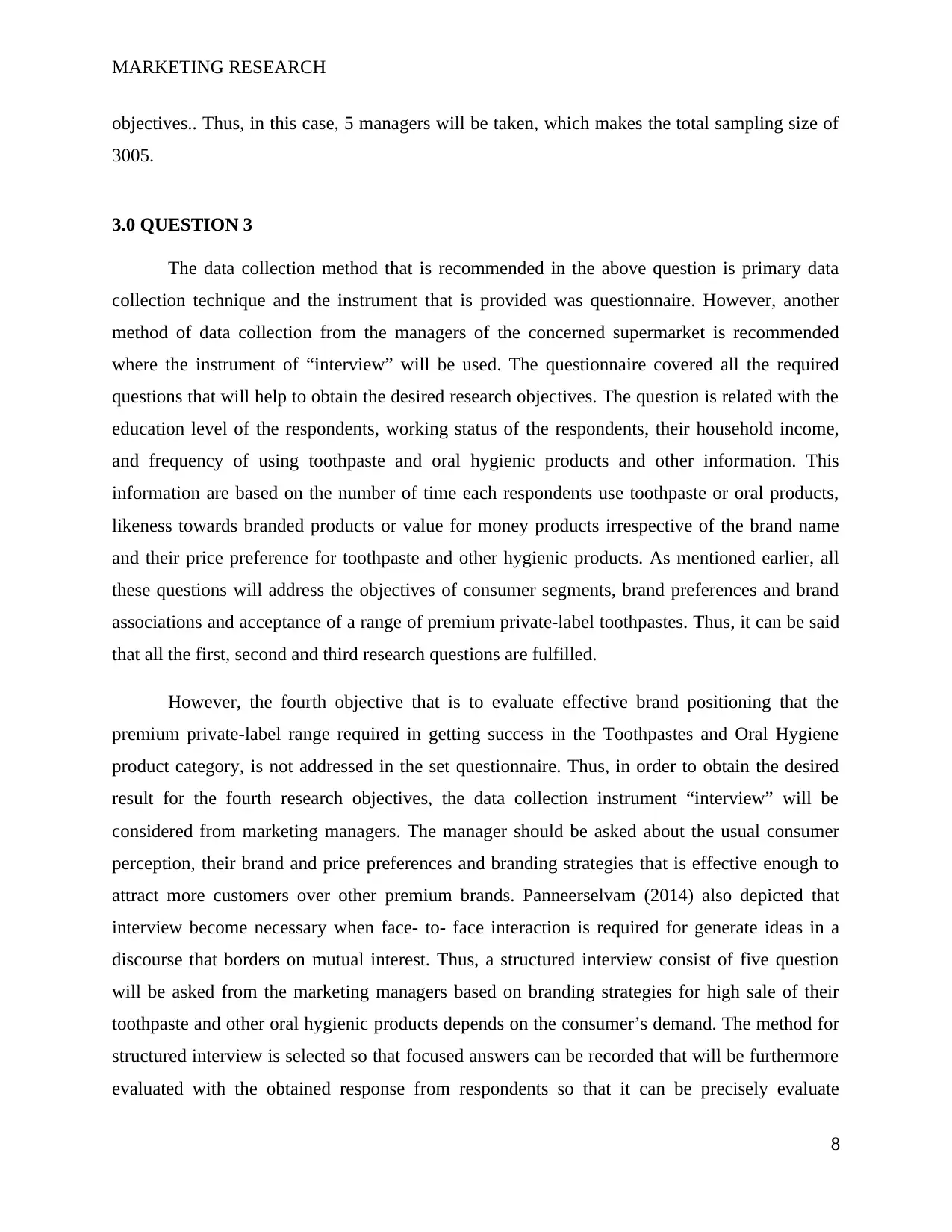
MARKETING RESEARCH
objectives.. Thus, in this case, 5 managers will be taken, which makes the total sampling size of
3005.
3.0 QUESTION 3
The data collection method that is recommended in the above question is primary data
collection technique and the instrument that is provided was questionnaire. However, another
method of data collection from the managers of the concerned supermarket is recommended
where the instrument of “interview” will be used. The questionnaire covered all the required
questions that will help to obtain the desired research objectives. The question is related with the
education level of the respondents, working status of the respondents, their household income,
and frequency of using toothpaste and oral hygienic products and other information. This
information are based on the number of time each respondents use toothpaste or oral products,
likeness towards branded products or value for money products irrespective of the brand name
and their price preference for toothpaste and other hygienic products. As mentioned earlier, all
these questions will address the objectives of consumer segments, brand preferences and brand
associations and acceptance of a range of premium private-label toothpastes. Thus, it can be said
that all the first, second and third research questions are fulfilled.
However, the fourth objective that is to evaluate effective brand positioning that the
premium private-label range required in getting success in the Toothpastes and Oral Hygiene
product category, is not addressed in the set questionnaire. Thus, in order to obtain the desired
result for the fourth research objectives, the data collection instrument “interview” will be
considered from marketing managers. The manager should be asked about the usual consumer
perception, their brand and price preferences and branding strategies that is effective enough to
attract more customers over other premium brands. Panneerselvam (2014) also depicted that
interview become necessary when face- to- face interaction is required for generate ideas in a
discourse that borders on mutual interest. Thus, a structured interview consist of five question
will be asked from the marketing managers based on branding strategies for high sale of their
toothpaste and other oral hygienic products depends on the consumer’s demand. The method for
structured interview is selected so that focused answers can be recorded that will be furthermore
evaluated with the obtained response from respondents so that it can be precisely evaluate
8
objectives.. Thus, in this case, 5 managers will be taken, which makes the total sampling size of
3005.
3.0 QUESTION 3
The data collection method that is recommended in the above question is primary data
collection technique and the instrument that is provided was questionnaire. However, another
method of data collection from the managers of the concerned supermarket is recommended
where the instrument of “interview” will be used. The questionnaire covered all the required
questions that will help to obtain the desired research objectives. The question is related with the
education level of the respondents, working status of the respondents, their household income,
and frequency of using toothpaste and oral hygienic products and other information. This
information are based on the number of time each respondents use toothpaste or oral products,
likeness towards branded products or value for money products irrespective of the brand name
and their price preference for toothpaste and other hygienic products. As mentioned earlier, all
these questions will address the objectives of consumer segments, brand preferences and brand
associations and acceptance of a range of premium private-label toothpastes. Thus, it can be said
that all the first, second and third research questions are fulfilled.
However, the fourth objective that is to evaluate effective brand positioning that the
premium private-label range required in getting success in the Toothpastes and Oral Hygiene
product category, is not addressed in the set questionnaire. Thus, in order to obtain the desired
result for the fourth research objectives, the data collection instrument “interview” will be
considered from marketing managers. The manager should be asked about the usual consumer
perception, their brand and price preferences and branding strategies that is effective enough to
attract more customers over other premium brands. Panneerselvam (2014) also depicted that
interview become necessary when face- to- face interaction is required for generate ideas in a
discourse that borders on mutual interest. Thus, a structured interview consist of five question
will be asked from the marketing managers based on branding strategies for high sale of their
toothpaste and other oral hygienic products depends on the consumer’s demand. The method for
structured interview is selected so that focused answers can be recorded that will be furthermore
evaluated with the obtained response from respondents so that it can be precisely evaluate
8
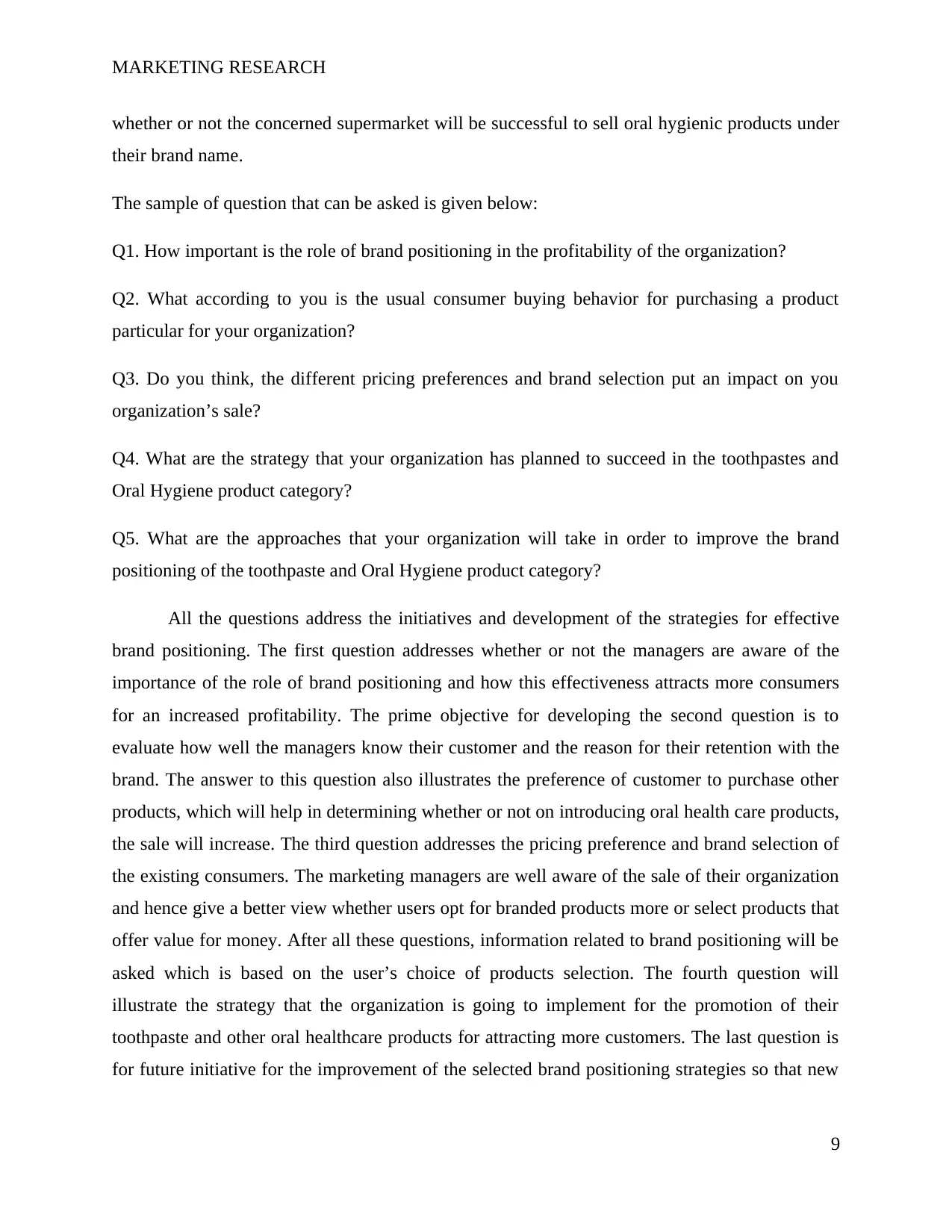
MARKETING RESEARCH
whether or not the concerned supermarket will be successful to sell oral hygienic products under
their brand name.
The sample of question that can be asked is given below:
Q1. How important is the role of brand positioning in the profitability of the organization?
Q2. What according to you is the usual consumer buying behavior for purchasing a product
particular for your organization?
Q3. Do you think, the different pricing preferences and brand selection put an impact on you
organization’s sale?
Q4. What are the strategy that your organization has planned to succeed in the toothpastes and
Oral Hygiene product category?
Q5. What are the approaches that your organization will take in order to improve the brand
positioning of the toothpaste and Oral Hygiene product category?
All the questions address the initiatives and development of the strategies for effective
brand positioning. The first question addresses whether or not the managers are aware of the
importance of the role of brand positioning and how this effectiveness attracts more consumers
for an increased profitability. The prime objective for developing the second question is to
evaluate how well the managers know their customer and the reason for their retention with the
brand. The answer to this question also illustrates the preference of customer to purchase other
products, which will help in determining whether or not on introducing oral health care products,
the sale will increase. The third question addresses the pricing preference and brand selection of
the existing consumers. The marketing managers are well aware of the sale of their organization
and hence give a better view whether users opt for branded products more or select products that
offer value for money. After all these questions, information related to brand positioning will be
asked which is based on the user’s choice of products selection. The fourth question will
illustrate the strategy that the organization is going to implement for the promotion of their
toothpaste and other oral healthcare products for attracting more customers. The last question is
for future initiative for the improvement of the selected brand positioning strategies so that new
9
whether or not the concerned supermarket will be successful to sell oral hygienic products under
their brand name.
The sample of question that can be asked is given below:
Q1. How important is the role of brand positioning in the profitability of the organization?
Q2. What according to you is the usual consumer buying behavior for purchasing a product
particular for your organization?
Q3. Do you think, the different pricing preferences and brand selection put an impact on you
organization’s sale?
Q4. What are the strategy that your organization has planned to succeed in the toothpastes and
Oral Hygiene product category?
Q5. What are the approaches that your organization will take in order to improve the brand
positioning of the toothpaste and Oral Hygiene product category?
All the questions address the initiatives and development of the strategies for effective
brand positioning. The first question addresses whether or not the managers are aware of the
importance of the role of brand positioning and how this effectiveness attracts more consumers
for an increased profitability. The prime objective for developing the second question is to
evaluate how well the managers know their customer and the reason for their retention with the
brand. The answer to this question also illustrates the preference of customer to purchase other
products, which will help in determining whether or not on introducing oral health care products,
the sale will increase. The third question addresses the pricing preference and brand selection of
the existing consumers. The marketing managers are well aware of the sale of their organization
and hence give a better view whether users opt for branded products more or select products that
offer value for money. After all these questions, information related to brand positioning will be
asked which is based on the user’s choice of products selection. The fourth question will
illustrate the strategy that the organization is going to implement for the promotion of their
toothpaste and other oral healthcare products for attracting more customers. The last question is
for future initiative for the improvement of the selected brand positioning strategies so that new
9
Secure Best Marks with AI Grader
Need help grading? Try our AI Grader for instant feedback on your assignments.
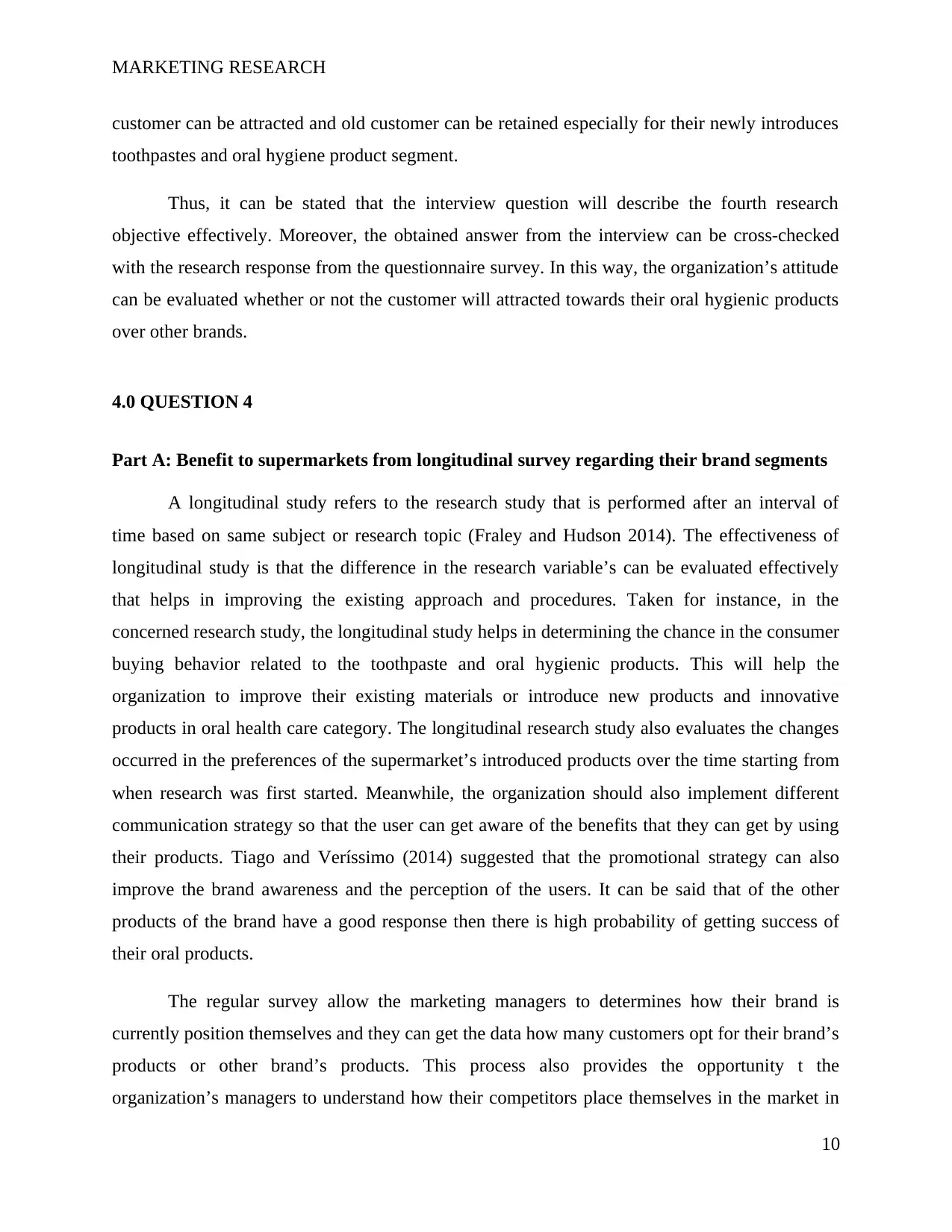
MARKETING RESEARCH
customer can be attracted and old customer can be retained especially for their newly introduces
toothpastes and oral hygiene product segment.
Thus, it can be stated that the interview question will describe the fourth research
objective effectively. Moreover, the obtained answer from the interview can be cross-checked
with the research response from the questionnaire survey. In this way, the organization’s attitude
can be evaluated whether or not the customer will attracted towards their oral hygienic products
over other brands.
4.0 QUESTION 4
Part A: Benefit to supermarkets from longitudinal survey regarding their brand segments
A longitudinal study refers to the research study that is performed after an interval of
time based on same subject or research topic (Fraley and Hudson 2014). The effectiveness of
longitudinal study is that the difference in the research variable’s can be evaluated effectively
that helps in improving the existing approach and procedures. Taken for instance, in the
concerned research study, the longitudinal study helps in determining the chance in the consumer
buying behavior related to the toothpaste and oral hygienic products. This will help the
organization to improve their existing materials or introduce new products and innovative
products in oral health care category. The longitudinal research study also evaluates the changes
occurred in the preferences of the supermarket’s introduced products over the time starting from
when research was first started. Meanwhile, the organization should also implement different
communication strategy so that the user can get aware of the benefits that they can get by using
their products. Tiago and Veríssimo (2014) suggested that the promotional strategy can also
improve the brand awareness and the perception of the users. It can be said that of the other
products of the brand have a good response then there is high probability of getting success of
their oral products.
The regular survey allow the marketing managers to determines how their brand is
currently position themselves and they can get the data how many customers opt for their brand’s
products or other brand’s products. This process also provides the opportunity t the
organization’s managers to understand how their competitors place themselves in the market in
10
customer can be attracted and old customer can be retained especially for their newly introduces
toothpastes and oral hygiene product segment.
Thus, it can be stated that the interview question will describe the fourth research
objective effectively. Moreover, the obtained answer from the interview can be cross-checked
with the research response from the questionnaire survey. In this way, the organization’s attitude
can be evaluated whether or not the customer will attracted towards their oral hygienic products
over other brands.
4.0 QUESTION 4
Part A: Benefit to supermarkets from longitudinal survey regarding their brand segments
A longitudinal study refers to the research study that is performed after an interval of
time based on same subject or research topic (Fraley and Hudson 2014). The effectiveness of
longitudinal study is that the difference in the research variable’s can be evaluated effectively
that helps in improving the existing approach and procedures. Taken for instance, in the
concerned research study, the longitudinal study helps in determining the chance in the consumer
buying behavior related to the toothpaste and oral hygienic products. This will help the
organization to improve their existing materials or introduce new products and innovative
products in oral health care category. The longitudinal research study also evaluates the changes
occurred in the preferences of the supermarket’s introduced products over the time starting from
when research was first started. Meanwhile, the organization should also implement different
communication strategy so that the user can get aware of the benefits that they can get by using
their products. Tiago and Veríssimo (2014) suggested that the promotional strategy can also
improve the brand awareness and the perception of the users. It can be said that of the other
products of the brand have a good response then there is high probability of getting success of
their oral products.
The regular survey allow the marketing managers to determines how their brand is
currently position themselves and they can get the data how many customers opt for their brand’s
products or other brand’s products. This process also provides the opportunity t the
organization’s managers to understand how their competitors place themselves in the market in
10
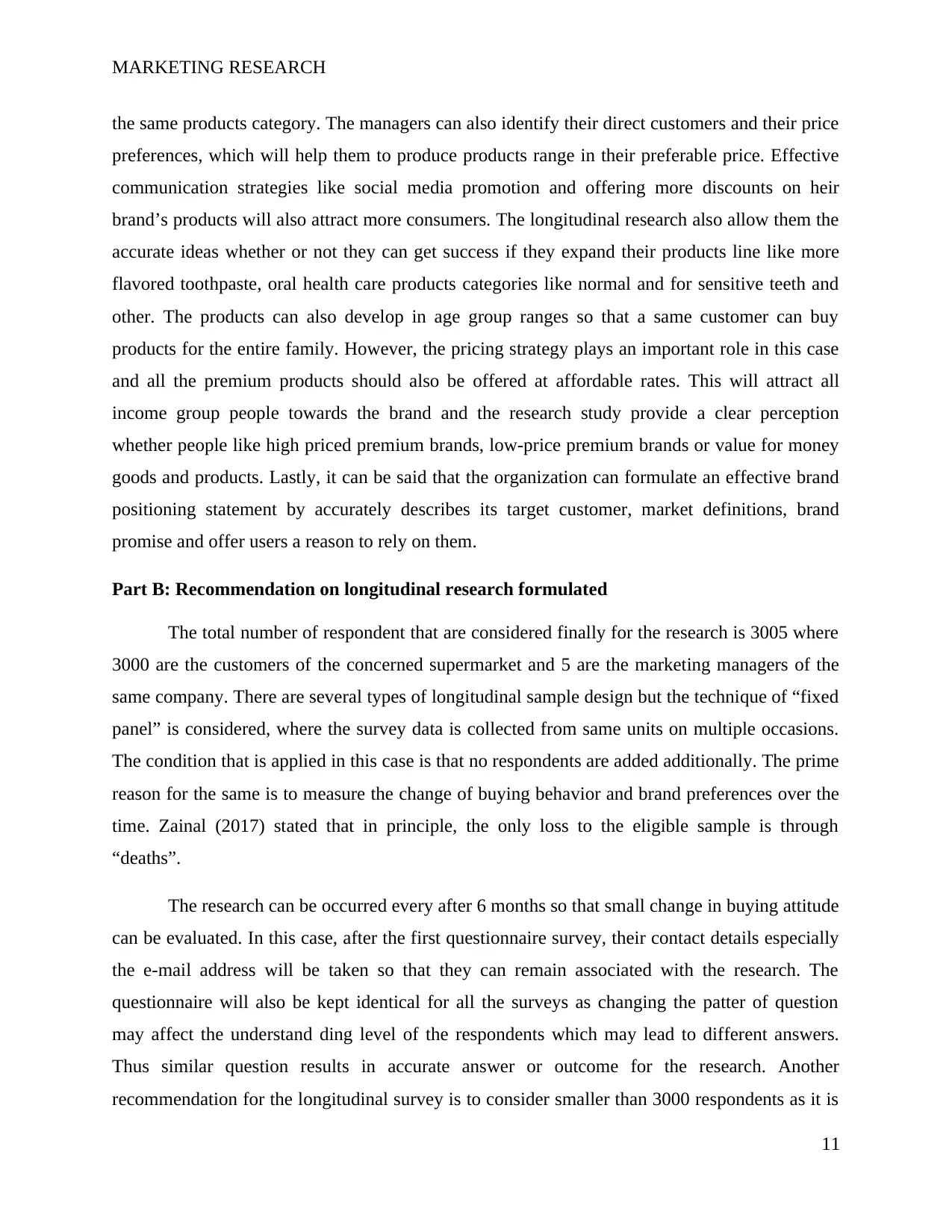
MARKETING RESEARCH
the same products category. The managers can also identify their direct customers and their price
preferences, which will help them to produce products range in their preferable price. Effective
communication strategies like social media promotion and offering more discounts on heir
brand’s products will also attract more consumers. The longitudinal research also allow them the
accurate ideas whether or not they can get success if they expand their products line like more
flavored toothpaste, oral health care products categories like normal and for sensitive teeth and
other. The products can also develop in age group ranges so that a same customer can buy
products for the entire family. However, the pricing strategy plays an important role in this case
and all the premium products should also be offered at affordable rates. This will attract all
income group people towards the brand and the research study provide a clear perception
whether people like high priced premium brands, low-price premium brands or value for money
goods and products. Lastly, it can be said that the organization can formulate an effective brand
positioning statement by accurately describes its target customer, market definitions, brand
promise and offer users a reason to rely on them.
Part B: Recommendation on longitudinal research formulated
The total number of respondent that are considered finally for the research is 3005 where
3000 are the customers of the concerned supermarket and 5 are the marketing managers of the
same company. There are several types of longitudinal sample design but the technique of “fixed
panel” is considered, where the survey data is collected from same units on multiple occasions.
The condition that is applied in this case is that no respondents are added additionally. The prime
reason for the same is to measure the change of buying behavior and brand preferences over the
time. Zainal (2017) stated that in principle, the only loss to the eligible sample is through
“deaths”.
The research can be occurred every after 6 months so that small change in buying attitude
can be evaluated. In this case, after the first questionnaire survey, their contact details especially
the e-mail address will be taken so that they can remain associated with the research. The
questionnaire will also be kept identical for all the surveys as changing the patter of question
may affect the understand ding level of the respondents which may lead to different answers.
Thus similar question results in accurate answer or outcome for the research. Another
recommendation for the longitudinal survey is to consider smaller than 3000 respondents as it is
11
the same products category. The managers can also identify their direct customers and their price
preferences, which will help them to produce products range in their preferable price. Effective
communication strategies like social media promotion and offering more discounts on heir
brand’s products will also attract more consumers. The longitudinal research also allow them the
accurate ideas whether or not they can get success if they expand their products line like more
flavored toothpaste, oral health care products categories like normal and for sensitive teeth and
other. The products can also develop in age group ranges so that a same customer can buy
products for the entire family. However, the pricing strategy plays an important role in this case
and all the premium products should also be offered at affordable rates. This will attract all
income group people towards the brand and the research study provide a clear perception
whether people like high priced premium brands, low-price premium brands or value for money
goods and products. Lastly, it can be said that the organization can formulate an effective brand
positioning statement by accurately describes its target customer, market definitions, brand
promise and offer users a reason to rely on them.
Part B: Recommendation on longitudinal research formulated
The total number of respondent that are considered finally for the research is 3005 where
3000 are the customers of the concerned supermarket and 5 are the marketing managers of the
same company. There are several types of longitudinal sample design but the technique of “fixed
panel” is considered, where the survey data is collected from same units on multiple occasions.
The condition that is applied in this case is that no respondents are added additionally. The prime
reason for the same is to measure the change of buying behavior and brand preferences over the
time. Zainal (2017) stated that in principle, the only loss to the eligible sample is through
“deaths”.
The research can be occurred every after 6 months so that small change in buying attitude
can be evaluated. In this case, after the first questionnaire survey, their contact details especially
the e-mail address will be taken so that they can remain associated with the research. The
questionnaire will also be kept identical for all the surveys as changing the patter of question
may affect the understand ding level of the respondents which may lead to different answers.
Thus similar question results in accurate answer or outcome for the research. Another
recommendation for the longitudinal survey is to consider smaller than 3000 respondents as it is
11
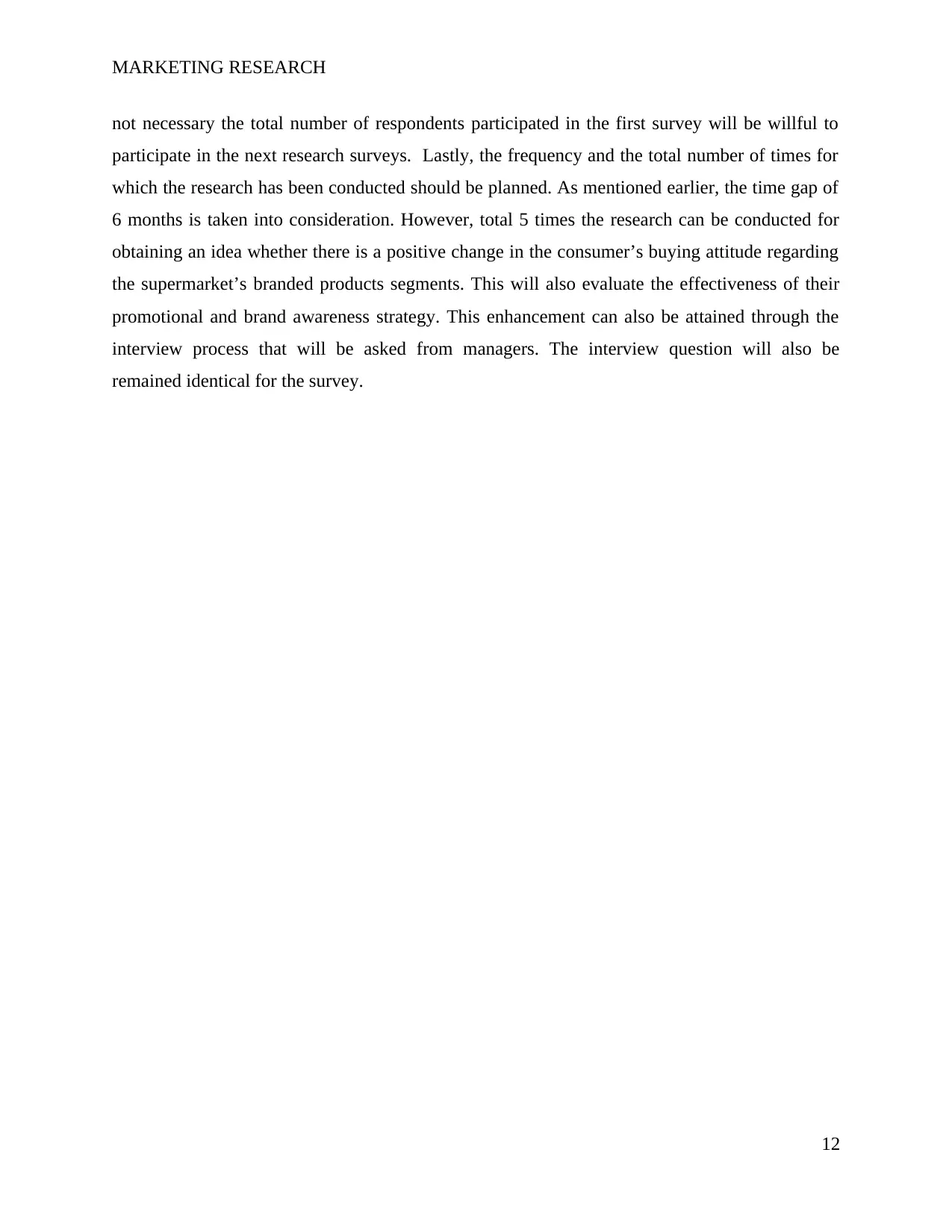
MARKETING RESEARCH
not necessary the total number of respondents participated in the first survey will be willful to
participate in the next research surveys. Lastly, the frequency and the total number of times for
which the research has been conducted should be planned. As mentioned earlier, the time gap of
6 months is taken into consideration. However, total 5 times the research can be conducted for
obtaining an idea whether there is a positive change in the consumer’s buying attitude regarding
the supermarket’s branded products segments. This will also evaluate the effectiveness of their
promotional and brand awareness strategy. This enhancement can also be attained through the
interview process that will be asked from managers. The interview question will also be
remained identical for the survey.
12
not necessary the total number of respondents participated in the first survey will be willful to
participate in the next research surveys. Lastly, the frequency and the total number of times for
which the research has been conducted should be planned. As mentioned earlier, the time gap of
6 months is taken into consideration. However, total 5 times the research can be conducted for
obtaining an idea whether there is a positive change in the consumer’s buying attitude regarding
the supermarket’s branded products segments. This will also evaluate the effectiveness of their
promotional and brand awareness strategy. This enhancement can also be attained through the
interview process that will be asked from managers. The interview question will also be
remained identical for the survey.
12
Paraphrase This Document
Need a fresh take? Get an instant paraphrase of this document with our AI Paraphraser
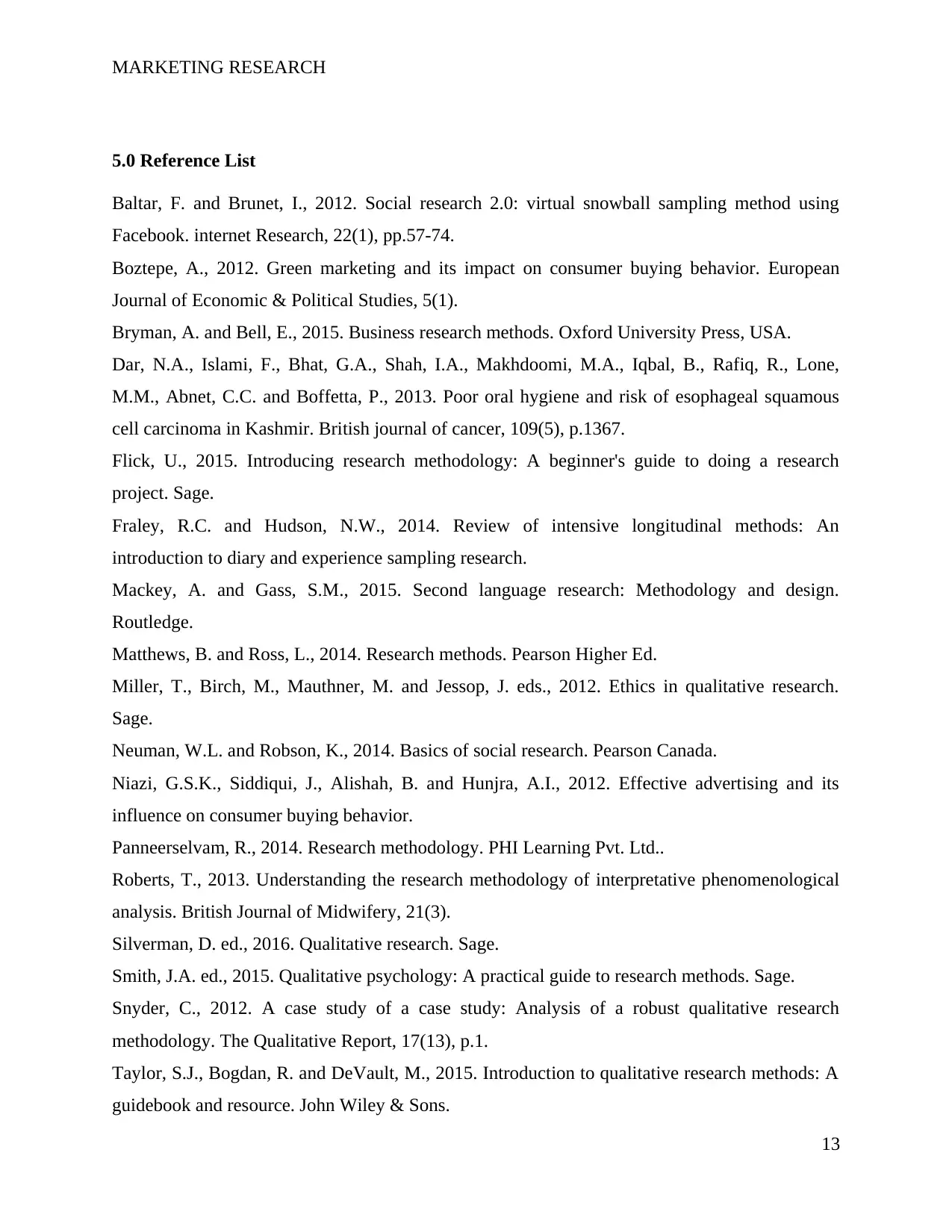
MARKETING RESEARCH
5.0 Reference List
Baltar, F. and Brunet, I., 2012. Social research 2.0: virtual snowball sampling method using
Facebook. internet Research, 22(1), pp.57-74.
Boztepe, A., 2012. Green marketing and its impact on consumer buying behavior. European
Journal of Economic & Political Studies, 5(1).
Bryman, A. and Bell, E., 2015. Business research methods. Oxford University Press, USA.
Dar, N.A., Islami, F., Bhat, G.A., Shah, I.A., Makhdoomi, M.A., Iqbal, B., Rafiq, R., Lone,
M.M., Abnet, C.C. and Boffetta, P., 2013. Poor oral hygiene and risk of esophageal squamous
cell carcinoma in Kashmir. British journal of cancer, 109(5), p.1367.
Flick, U., 2015. Introducing research methodology: A beginner's guide to doing a research
project. Sage.
Fraley, R.C. and Hudson, N.W., 2014. Review of intensive longitudinal methods: An
introduction to diary and experience sampling research.
Mackey, A. and Gass, S.M., 2015. Second language research: Methodology and design.
Routledge.
Matthews, B. and Ross, L., 2014. Research methods. Pearson Higher Ed.
Miller, T., Birch, M., Mauthner, M. and Jessop, J. eds., 2012. Ethics in qualitative research.
Sage.
Neuman, W.L. and Robson, K., 2014. Basics of social research. Pearson Canada.
Niazi, G.S.K., Siddiqui, J., Alishah, B. and Hunjra, A.I., 2012. Effective advertising and its
influence on consumer buying behavior.
Panneerselvam, R., 2014. Research methodology. PHI Learning Pvt. Ltd..
Roberts, T., 2013. Understanding the research methodology of interpretative phenomenological
analysis. British Journal of Midwifery, 21(3).
Silverman, D. ed., 2016. Qualitative research. Sage.
Smith, J.A. ed., 2015. Qualitative psychology: A practical guide to research methods. Sage.
Snyder, C., 2012. A case study of a case study: Analysis of a robust qualitative research
methodology. The Qualitative Report, 17(13), p.1.
Taylor, S.J., Bogdan, R. and DeVault, M., 2015. Introduction to qualitative research methods: A
guidebook and resource. John Wiley & Sons.
13
5.0 Reference List
Baltar, F. and Brunet, I., 2012. Social research 2.0: virtual snowball sampling method using
Facebook. internet Research, 22(1), pp.57-74.
Boztepe, A., 2012. Green marketing and its impact on consumer buying behavior. European
Journal of Economic & Political Studies, 5(1).
Bryman, A. and Bell, E., 2015. Business research methods. Oxford University Press, USA.
Dar, N.A., Islami, F., Bhat, G.A., Shah, I.A., Makhdoomi, M.A., Iqbal, B., Rafiq, R., Lone,
M.M., Abnet, C.C. and Boffetta, P., 2013. Poor oral hygiene and risk of esophageal squamous
cell carcinoma in Kashmir. British journal of cancer, 109(5), p.1367.
Flick, U., 2015. Introducing research methodology: A beginner's guide to doing a research
project. Sage.
Fraley, R.C. and Hudson, N.W., 2014. Review of intensive longitudinal methods: An
introduction to diary and experience sampling research.
Mackey, A. and Gass, S.M., 2015. Second language research: Methodology and design.
Routledge.
Matthews, B. and Ross, L., 2014. Research methods. Pearson Higher Ed.
Miller, T., Birch, M., Mauthner, M. and Jessop, J. eds., 2012. Ethics in qualitative research.
Sage.
Neuman, W.L. and Robson, K., 2014. Basics of social research. Pearson Canada.
Niazi, G.S.K., Siddiqui, J., Alishah, B. and Hunjra, A.I., 2012. Effective advertising and its
influence on consumer buying behavior.
Panneerselvam, R., 2014. Research methodology. PHI Learning Pvt. Ltd..
Roberts, T., 2013. Understanding the research methodology of interpretative phenomenological
analysis. British Journal of Midwifery, 21(3).
Silverman, D. ed., 2016. Qualitative research. Sage.
Smith, J.A. ed., 2015. Qualitative psychology: A practical guide to research methods. Sage.
Snyder, C., 2012. A case study of a case study: Analysis of a robust qualitative research
methodology. The Qualitative Report, 17(13), p.1.
Taylor, S.J., Bogdan, R. and DeVault, M., 2015. Introduction to qualitative research methods: A
guidebook and resource. John Wiley & Sons.
13
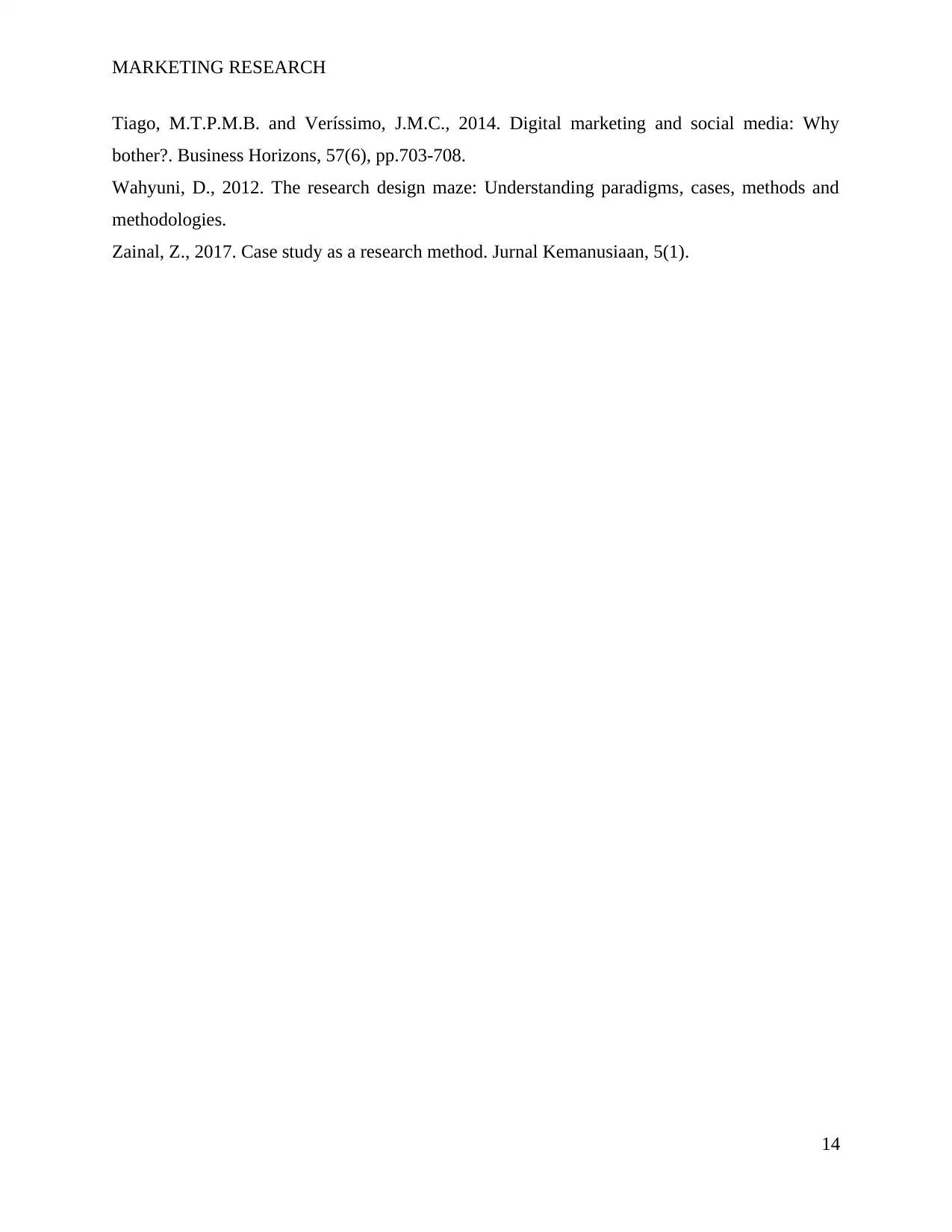
MARKETING RESEARCH
Tiago, M.T.P.M.B. and Veríssimo, J.M.C., 2014. Digital marketing and social media: Why
bother?. Business Horizons, 57(6), pp.703-708.
Wahyuni, D., 2012. The research design maze: Understanding paradigms, cases, methods and
methodologies.
Zainal, Z., 2017. Case study as a research method. Jurnal Kemanusiaan, 5(1).
14
Tiago, M.T.P.M.B. and Veríssimo, J.M.C., 2014. Digital marketing and social media: Why
bother?. Business Horizons, 57(6), pp.703-708.
Wahyuni, D., 2012. The research design maze: Understanding paradigms, cases, methods and
methodologies.
Zainal, Z., 2017. Case study as a research method. Jurnal Kemanusiaan, 5(1).
14
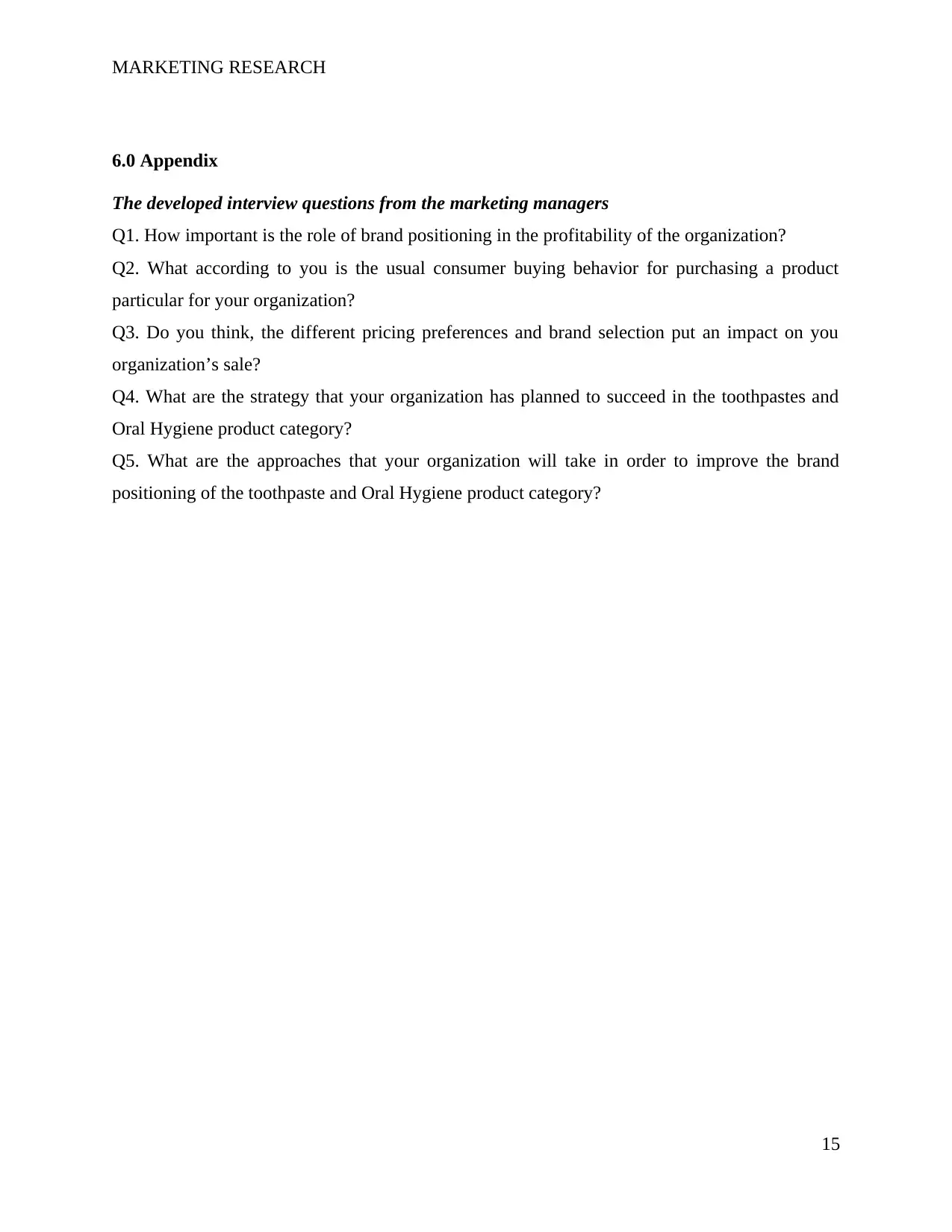
MARKETING RESEARCH
6.0 Appendix
The developed interview questions from the marketing managers
Q1. How important is the role of brand positioning in the profitability of the organization?
Q2. What according to you is the usual consumer buying behavior for purchasing a product
particular for your organization?
Q3. Do you think, the different pricing preferences and brand selection put an impact on you
organization’s sale?
Q4. What are the strategy that your organization has planned to succeed in the toothpastes and
Oral Hygiene product category?
Q5. What are the approaches that your organization will take in order to improve the brand
positioning of the toothpaste and Oral Hygiene product category?
15
6.0 Appendix
The developed interview questions from the marketing managers
Q1. How important is the role of brand positioning in the profitability of the organization?
Q2. What according to you is the usual consumer buying behavior for purchasing a product
particular for your organization?
Q3. Do you think, the different pricing preferences and brand selection put an impact on you
organization’s sale?
Q4. What are the strategy that your organization has planned to succeed in the toothpastes and
Oral Hygiene product category?
Q5. What are the approaches that your organization will take in order to improve the brand
positioning of the toothpaste and Oral Hygiene product category?
15
1 out of 16
Related Documents
Your All-in-One AI-Powered Toolkit for Academic Success.
+13062052269
info@desklib.com
Available 24*7 on WhatsApp / Email
![[object Object]](/_next/static/media/star-bottom.7253800d.svg)
Unlock your academic potential
© 2024 | Zucol Services PVT LTD | All rights reserved.





